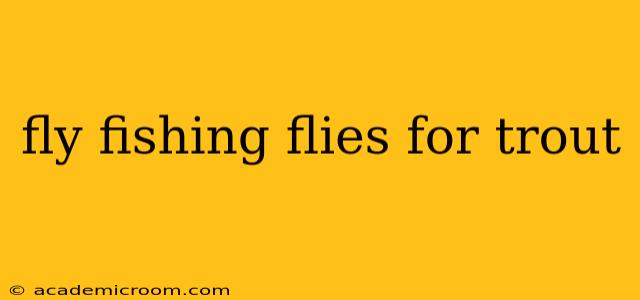Fly fishing for trout is a rewarding pursuit, but choosing the right fly can significantly impact your success. This guide delves into the world of trout flies, covering various types, their applications, and how to select the best ones for different situations. We'll explore popular patterns, materials, and techniques to help you become a more effective trout angler.
What are the best fly fishing flies for trout?
This is a question with no single answer! The "best" fly depends heavily on several factors, including the time of year, the water conditions (clear, murky, fast, slow), the type of trout you're targeting, and even the specific location. However, some patterns consistently prove effective across a range of situations. These include:
-
Adams: A classic dry fly, the Adams imitates various mayflies and is effective in a wide array of conditions. Its simple design makes it easy to tie and fish.
-
Royal Wulff: Another versatile dry fly, known for its bright colors and ability to attract attention, even on cloudy days.
-
Elk Hair Caddis: This dry fly imitates caddisflies, a crucial food source for many trout. Its buoyant elk hair makes it ride high on the water's surface.
-
Stimulator: A large, attractor dry fly that works well when trout are feeding aggressively.
-
Prince Nymph: A versatile nymph pattern that imitates a variety of aquatic insects. Its weighted design allows it to sink effectively.
-
Pheasant Tail Nymph: Another popular nymph, known for its simple yet effective design and its ability to imitate many different aquatic insects.
-
Wooly Bugger: A versatile streamer fly effective for both surface and subsurface fishing, mimicking small baitfish and insects.
What are the most effective trout flies?
Effectiveness isn't solely determined by the fly's design but also by its presentation. A perfectly tied fly presented poorly will likely fail to entice a trout. The most effective flies are often those that closely mimic the insects trout are actively feeding on at a particular time and place. Observe the insects emerging from the water or hatching on the surface—this will guide your fly selection.
What size flies should I use for trout?
Fly size is crucial, and it varies based on the size of the trout you're targeting and the insects they're feeding on. Smaller flies (sizes 16-22) are generally best for selective trout feeding on small insects. Larger flies (sizes 6-12) might be necessary when trout are feeding more aggressively or on larger prey. Experimentation will help you determine the optimal size for your specific situation.
What colors of flies are best for trout?
Trout are sensitive to light and color variations in the water. Natural colors that mimic insects are usually best, such as olive, brown, tan, and black. However, brighter colors can be effective in low-light conditions or when trout are less selective. Don't be afraid to experiment with different color combinations to see what works best.
What materials are used to make trout flies?
A wide range of materials is used in fly tying, including feathers (such as pheasant tails, hen hackles, and grizzly hackles), synthetic fibers, fur (such as deer hair and rabbit fur), and various types of thread. The choice of materials depends on the specific fly pattern and its intended purpose.
How do I choose the right fly for different water conditions?
-
Clear water: Use flies that closely mimic the natural insects present. Subtlety is key.
-
Murky water: Use larger, more brightly colored flies to attract attention.
-
Fast water: Use heavier flies that can sink quickly and stay in the current.
-
Slow water: Use lighter flies that drift naturally on the surface or in the water column.
Conclusion
Selecting the right fly for trout fishing is a process of observation, experimentation, and learning. By understanding the different types of flies, their applications, and the factors that influence their effectiveness, you'll significantly increase your chances of success on the water. Remember to always respect the environment and practice catch-and-release fishing whenever possible.
